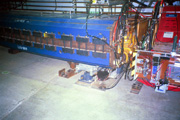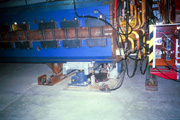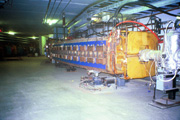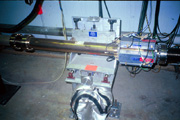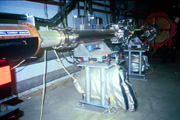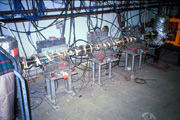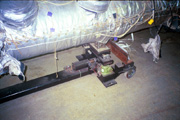Photos of the Motorized Magnet Stands Larry Bartoszek worked on at FermilabThe Antiproton Source is a unique accelerator in the U.S. as a storage ring for antiprotons, and has many features not found in other accelerators at Fermilab. Among these is a host of beam diagnostic equipment, many of which have very small apertures for the antiproton beam to get through. Antiprotons are very hard to make, collect, and store so each one is precious and expensive. Small apertures are the places where the beam is most likely to scrape against the walls of the vacuum chamber, and any beam that scrapes is lost. To make it easier to adjust the accelerators in the Source to preserve antiprotons and prevent beam losses, most of the small aperture devices were mounted on remotely controlled motorized stands to allow them to be repositioned without anyone entering the Source. (Personnel access is potentially lethal during beam-on conditions, so to make an access to the tunnel the beam would have to be dumped each time.) Using beam loss monitors, the effect of small adjustments to the aperture positions can be studied and optimized quickly. Besides preventing beam scraping on small apertures, another reason for mounting a device on a motorized rotating stand is that changing the position of some devices (primarily magnets) is a way to tune the accelerator and improve its performance. Moving quadrapole and dipole magnets changes the shape and timing of the orbit of the antiprotons. There isn't much room in many places in the Accumulator to put even small trim magnets, so one of the experiments performed in the Source was to rotate the large horizontally bending dipole magnets by very small amounts to give them the effect of tiny vertical bending dipole magnets as well as horizontal dipoles. During the first eight years of working at Fermilab, Larry was the only mechanical engineer assigned directly to the Antiproton Source Department. (Other mechanical support came from the Accelerator Division Mechanical Support Department.) Larry and Joel Misek of the MSD designed all of the remotely motorized stands in the Antiproton Source. Each time a new requirement came along, they fine-tuned their designs and tried new concepts and components. Ultimately, they ended up with a series of modular components that could be fabricated ahead of time and bolted together in different configurations to achieve horizontal, vertical, or both adjustments on a variety of beam components. Larry Bartoszek took these pictures while employed at Fermilab. (Presentation of photos from Fermilab does not imply endorsement of any product or service.) You are welcome to download any of the images. If they are used for other than private viewing, credit to Bartoszek Engineering and Fermilab would be appreciated.
This stand features two Simplex jacks to support the 50 ton dipole that are connected to a reversing bevel gear box driven by a stepper motor. The reversing gearbox has two output shafts that rotate in opposite directions so as one jack raises, the other lowers. This is what produces the rotation that turns the horizontal dipole into a combined horizontal bender and vertical trim magnet. The other end of the magnet rotates on a single pivot point.
The stand hardware next to the aluminum structure of the motorized stand is the original manually adjusted magnet stand.
This stand has the same design as the large dipole stand, but somewhat lower capacity components for the lighter weight of the "small" dipoles.
This stand is a bit more open than its big brother making it easier to see the chain couplings that connect the drive system together, the LVDTs used to sense the position of the stand, (and the oil spilled out of the gear box from overfilling.)
Positioning the small aperture of the Lambertson magnet is critical to getting all of the antiprotons extracted from the Accumulator out of the accelerator and on their way to collisions in the Tevatron. This stand independently moves each end of the Lambertson horizontally only.
This is an example of one of the many versions of beam diagnostic stand of this type in the Antiproton Accumulator.
This is one of the newer designs of stands. It is motorized both vertically and horizontally, with a manual knob to set the zero of the positioning during initial alignment at installation into the ring. All of these stands has crude manual positioning ability at floor level just to get the stand oriented so that the beam sensing device it carries is parallel to the beam axis.
Schottky pick-ups are about the smallest apertures in the whole Accumulator, and were among the very first devices motorized.
Upgades to the Stochastic Cooling system generally put more small apertures in the ring that then needed to be motorized. This stand is one of the later models that incorporated everything learned in earlier versions. Because these devices have to be moved fairly far down the tunnel from where the crane lowers them in, (and fairly frequently for upgrades,) they are equipped with small caster modules that can be quick released and rotated upside down for storage on the stand.
These stands have the capability to be motorized either horizontally or vertically, with only vertical implemented on this one.
Back to the Projects Main Menu
Back to the People Main Menu
Back to the Bartoszek Engineering Home Page
|
